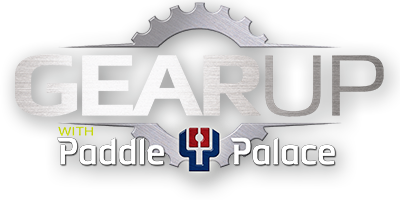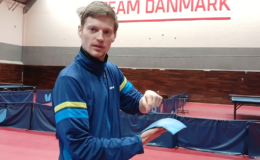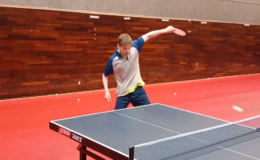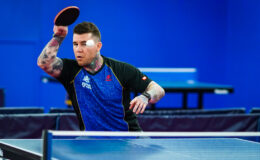By Larry Hodges, USATT Hall of Famer and National Coach
A lot of players have good forehands in practice, either looping or hitting. But once a game starts, they stand facing the table, which is a backhand stance, and while their backhands are fine, when the ball goes to their forehand they mostly face the table, bringing their arm back to stroke rather than turning sideways. This leaves them with an awkward forehand stroke. They have only a small hitting zone, and this small hitting zone is jammed over the table. They have no time or space to actually do a normal forehand swing, and so end up blocking or doing awkward strokes. Their stroke in almost entirely with the arm.
Afterwards, they go to the table and spend hours practicing their already-good forehand, never understanding why they are unable to use it in a game situation.
The key to fixing this problem (which afflicts most players at most levels to some degree) is to learn to open up the forehand zone. This means that somehow you have to turn your shoulders so they are roughly perpendicular to the table, i.e. parallel to the flight of the incoming ball. Once in this position, you can unleash your true forehand power with control and consistency. But how do you do this in a game situation, as opposed to just facing the table and bringing the arm back?
You do so by, in varying degrees, bringing your right foot back (for righties), turning at the waist, and turning the shoulders. You need a combination of all three. Players with quick feet might bring their back foot back more than others. Players with a more supple body might rotate more at the waist and shoulders. But the result must be the same – sideways to the table.
The problem is how to develop this habit? Here are two suggestions.
First, do a simple drill where your partner hits the ball side to side, and you alternate hitting backhands and forehands to the same spot (either partner’s forehand or backhand). When the ball goes to your forehand, focus on pulling with your right side so that you rotate completely about, perhaps even exaggerating it at first. The goal is to develop this habit of opening up the forehand zone.
When you are comfortable with this drill, do the same thing, but now have your partner hit the ball randomly to your forehand and backhand. Do it slow at first – the goal is to do it properly, or you’ll just re-enforce bad habits.
Second, consider hitting your backhands with a slight forehand stance. You probably don’t want to do this if you are looping your backhand, but for blocking and hitting many players keep their right foot slightly back, making it easier to transition to the forehand. (I often do this.) Experiment with this.
Trust me, if you have a good forehand in drills, you can do it in games, as long as you actually do it in games the way you do in practice – with the full forehand zone.



